How to Design a Website Complete Guide - October 2025
Written by UIDesignz Feb 22, 2024 3 min read
Last updated: Sep 8 2025

In the digital age of October 2025, having a well-designed website is extremely important for businesses and individuals alike. Whether you're starting from scratch or looking to revamp your existing site, mastering the art of web design services is essential to creating a compelling online presence. In this comprehensive guide, we'll walk you through the key steps and best practices to design a website that not only looks stunning but also delivers an exceptional user experience.
Table of Contents
Define Your Objectives
Before diving into the web design process, it's crucial to clearly define the objectives of your website. Are you aiming to showcase your portfolio, sell products, or provide information to visitors? Understanding your goals will guide the design direction and help prioritize features and content.

Define Your Objectives (image by 5Minutes SEO)
Research Your Audience
Successful website design starts with a deep understanding of your target audience. Conduct thorough research to identify their needs, preferences, and browsing behaviors. This insight will inform your design decisions, ensuring that your website resonates with your audience and effectively communicates your message.
Keep Reading: Factors to Consider When Choosing a Web Design Company
Choose The Right Platform
Selecting the right platform for your website is key to its success. Whether you opt for a content management system like WordPress, a website builder like Wix or Squarespace, or custom development, consider factors such as ease of use, customization options, and scalability.

Right Platform (image by Boost)
Plan your Site Structure
A well-organized site structure is essential for easy navigation and a great user experience. Create a sitemap outlining the hierarchy of pages and their relationships. Pay attention to intuitive navigation menus, clear call-to-action buttons, and logical pathways for visitors to explore your content.
Focus on Responsive Design
With the increasing prevalence of mobile devices, responsive website development is non-negotiable. Ensure that your website is optimized for seamless viewing across various screen sizes and devices. Test your design rigorously to guarantee a consistent and user-friendly experience for all visitors.
Prioritize Visual Appeal
The visual aesthetics of your website play a crucial role in capturing visitors' attention and conveying your brand and identity service. Choose a cohesive color palette, compelling imagery, and clean typography to create a visually engaging experience. Incorporate white space strategically to enhance readability and highlight key content.
Optimize for Performance
Website speed and performance are highly important for user satisfaction and search engine rankings. Optimize your site by minimizing code bloat, compressing images, and leveraging caching and content delivery networks (CDNs). Regularly monitor and optimize loading times to ensure a smooth browsing experience.

Optimize for Performance (image by Hyrrokkin)
Implement SEO Best Practices
Effective search engine optimization (SEO) is essential for driving organic traffic to your website. Incorporate relevant keywords into your content, meta tags, and URLs. Create high-quality, engaging content that resonates with your audience and encourages sharing and backlinking.
Test and Iterate
Once your website is live, continuous testing and iteration are key to refining its performance and user experience. Gather feedback from users, analyze website analytics, and A/B test design elements to identify areas for improvement and optimization.
Conclusion
By following these steps and incorporating best practices, you can design a website that not only captivates visitors with its visual appeal but also delivers a seamless and engaging user experience. Remember that website design is an ongoing process, and staying updated with the latest trends and technologies is essential for staying ahead in the ever-evolving digital landscape of July 2025.
To avail our offered services by Professionals kindly Contact Us.





